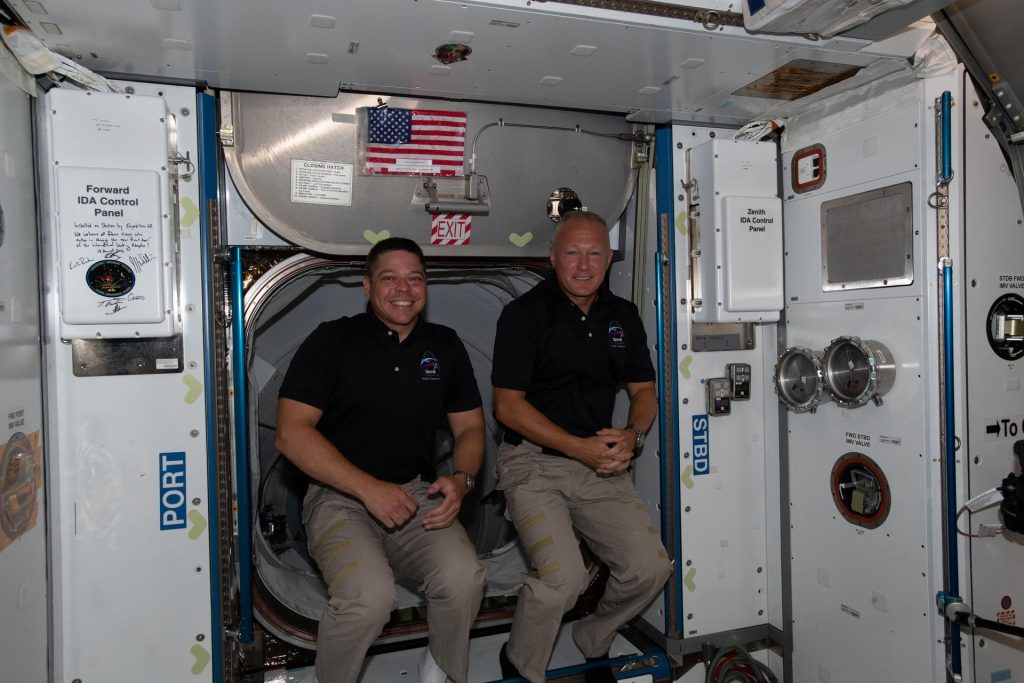
NASA astronauts Robert Behnken and Douglas Hurley are “Go” to return to Earth with a splashdown off the Florida coast on Sunday, Aug. 2, aboard the SpaceX Crew Dragon “Endeavour” spacecraft. The splashdown will wrap up NASA’s SpaceX Demo-2 mission after about two months at the International Space Station.

Teams from NASA and SpaceX met today to evaluate the plans and preparations for the return and recovery of the crew and spacecraft.
“The Return Flight Readiness Review is complete, and the teams — the NASA team, the SpaceX team — remain ‘Go’ for return, and we cannot wait to get Bob Behnken and Doug Hurley back to Earth,” NASA Administrator Jim Bridenstine said during a briefing that followed the conclusion of the day’s review.
NASA and SpaceX are targeting 7:34 p.m. EDT Saturday, Aug. 1, for undocking of the Dragon “Endeavour” spacecraft from the space station and 2:42 p.m. EDT on Sunday for splashdown, which will be the first return of a commercially built and operated American spacecraft carrying astronauts from the space station.
“We really took the time to review the vehicle on orbit,” said Steve Stich, manager of NASA’s Commercial Crew Program. “It’s been on orbit about 63 days. The systems on Crew Dragon are doing very well; the spacecraft is very healthy. We went through all the systems, any issues or problems that we saw on orbit in terms of how the vehicle responded to the thermal environment in different parts of space; we reviewed the readiness of the [operations] teams; and also the recovery teams. We came out of the FRR with a ‘Go’ to proceed toward undock, deorbit, and landing.”
An area of disturbed weather in the tropics could potentially organize into a tropical storm in the coming days, and NASA and SpaceX managers are closely watching its development. Teams will continue to evaluate the weather and splashdown criteria at seven potential splashdown sites around the Florida peninsula, including sites in the Gulf of Mexico and along the state’s Atlantic coast.
“Over the next few days, we’ll be carefully looking at the weather and getting ready for the undock and deorbit and landing. We’re going to watch the weather very carefully. We have a series of sites and many days. If we don’t undock on Saturday to come home on Sunday, we would move undocking to Monday,” Stich said, adding that the teams constantly monitor the weather and receive briefings prior to key decision points. “We’ll evaluate the weather each day and see how things unfold.”
The Crew Dragon spacecraft carrying Hurley and Behnken lifted off from NASA’s Kennedy Space Center in Florida on May 30 and arrived at the space station the following day. The Demo-2 test flight is helping NASA certify SpaceX’s crew transportation system for regular flights carrying astronauts to and from the orbiting laboratory. SpaceX is readying the hardware for the first rotational mission, which would occur following NASA certification.
“It’s been great to have Bob and Doug on board,” said Joel Montalbano, manager of NASA’s International Space Station Program. “They complemented the crew that came up on Soyuz in April. We were able to complete four EVAs and a tremendous amount of utilization, research, technology development. We worked cargo operations with the Japanese transfer vehicle. We had medical operations. These guys just contributed significantly to the station team, the International Space Station Program, and to NASA in general.”
The goal of NASA’s Commercial Crew Program is safe, reliable and cost-effective transportation to and from the International Space Station. This could allow for additional research time and increase the opportunity for discovery aboard humanity’s testbed for exploration, including helping us prepare for human exploration of the Moon and Mars.
For the moment, though, the teams are maintaining their focus on the successful conclusion of Demo-2 with a safe return and recovery for Behnken, Hurley, and the Crew Dragon spacecraft.
“I just want to say thank you to NASA, to the nation, to the American public, to all the international partners, and to everybody who’s put all their heart and soul and time into this,” said Benji Reed, SpaceX director of crew mission management. “We’ve got the next big step to go to bring those guys home, and we look forward to making it happen.”
More details about the mission and NASA’s commercial crew program can be found in the press kit online and by following the commercial crew blog, @commercial_crew and commercial crew on Facebook.
